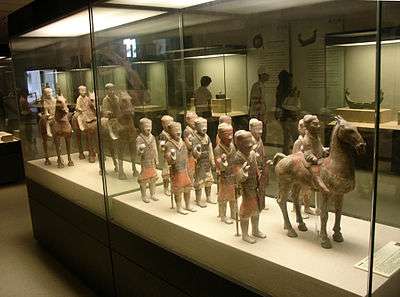First Chinese domination of Vietnam
| Bắc thuộc | |||||
| District of the Han Empire | |||||
| |||||
| Government | Monarchy | ||||
| History | |||||
| • | Han-Nam Việt War | 111 BC | |||
| • | Trưng Sisters' Uprising | 40 | |||
The first Chinese domination is a period in Vietnamese history during which Vietnam was under Chinese rule from the north.[1] It is the first of four periods of Chinese domination of Vietnam, the first three of which are almost continuous and referred to as Bắc thuộc ("Northern domination").
In 111 BC, the Han dynasty of China conquered the Nam Việt (or Nanyue) kingdom during its expansion southward and incorporated what is now northern Vietnam, together with much of modern Guangdong and Guangxi, into the expanding Han empire. Vietnamese resistance to Han rule culminated in the rebellion of the Trưng Sisters, who expelled the Han in 40 AD and briefly ruled Vietnam until being defeated by the returning Han army in 43 AD.
Administration
In 111 BC, the Han dynasty armies defeated the successors of Zhao Tuo (Triệu Đà) and incorporated Nam Việt and former Âu Lạc into the Han empire under the new name of Jiaozhi (Giao Chi), dividing the former kingdom into nine commanderies:[2]
- Nanhai (南海; Vietnamese: Nam Hải; located in Lingnan, modern central Guangdong)
- Hepu (合浦; Vietnamese: Hợp Phố; located in Lingnan, modern southern coastal Guangxi)
- Cangwu (蒼梧; Vietnamese: Thương Ngô; located in Lingnan, modern eastern Guangxi)
- Yulin (郁林/鬱林; Vietnamese: Uất Lâm; located in Lingnan, probably Guilin, modern northeastern Guangxi)
- Zhuya (珠崖; Vietnamese: Châu Nhai; located on Hainan)
- Dan'er (儋耳; Vietnamese: Đạm Nhĩ; located on Hainan),
- Jiaozhi (交趾; Vietnamese: Giao Chỉ; located in northern Vietnam and part of southern Guangxi)
- Jiuzhen (九真; Vietnamese: Cửu Chân; probably located in central Vietnam)
- Rinan (日南; Vietnamese: Nhật Nam; probably located in central Vietnam)
All nine districts were administered from Long Biên, near modern Hanoi;[3] each ruled by a Chinese mandarin while the old system of low er rank rulers of Lac Hau, Lac Tuong were kept unchanged.
Economy
The Vietnamese paid heavy tributes and taxes to the Hans. The Han mandarins tried to occupy large areas of land and changed them into Chinese style farms and brought Chinese peasants to work them. The Chinese attempted to impose Chinese culture, institutions, educational system, politics, language, art, music, architecture and religion on the Vietnamese, and imported Chinese administrators to replace the local nobility. However, implementation of a foreign administrative system and the Sinicization was not easy, frequent uprisings and rebellions were indicative of Vietnamese resistance to these changes.
Under foreign rule, the Vietnamese people had to adopt foreign writing system, but lost much of their spoken language, and their national identity.
The Hans were anxious to extend their control over the fertile Red River Delta, in part to serve as a convenient supply point for Han ships engaged in the growing maritime trade with South and Southeast Asia. During the first century of Chinese rule, Vietnam was governed leniently, and the Lạc lords maintained their feudal offices. In the first century A.D., however, the Han dynasty intensified its efforts to assimilate its new territories by raising taxes and instituting marriage reforms aimed at turning Vietnam into a patriarchal society more amenable to political authority.
History

Professor Liam Kelley wrote on how the 17th century Vietnamese historians like Ngô Thì Sĩ and Jesuits like Martinio Martini studied texts on the Hồng Bàng Dynasty like Đại Việt sử ký toàn thư and used mathematics to deduce that the information on them were nonsense given the impossible reign years of the monarchs. However, modern Vietnamese now believe that the information is true.[5] Ngô Thì Sĩ used critical analysis of historical texts to question the relations between Zhao Tuo's Nanyue Kingdom in Guangdong and the Vietnamese inhabited Red River Delta, concluding that the Red River Delta was a mere vassal to Nanyue and not an integral part of it in addition to criticizing the existence of the Hồng Bàng Dynasty.[6][7]
Modern Vietnamese nationalists seek to stress local Vietnamese influence in history and downplay the role of foreign origin monarchs like the fact that the family of the Tran dynasty rulers originated in China.[8] Vietnamese historians have sought to construct a fantasy of a continuous succession since the Hung Kings of local political units in Vietnam.[9] Vietnamese scholars and historians have debated over whether to regard Zhao Tuo as part of the "orthodox succession" of rulers or as "enemy invader".[10]
The Jiaqing Emperor refused Gia Long's request to change his country's name to Nam Việt, and changed the name instead to Việt Nam.[11] Gia Long's Đại Nam thực lục contains the diplomatic correspondence over the naming.[12]
Historical accounts of the Triệu Dynasty
There is a dispute as to whether the period of the Triệu dynasty was part of the first Chinese domination of Vietnam.
Trưng uprising
In response to increasingly oppressive Han rule, a revolt broke out in Jiaozhi, Jiuzhen (Cửu Chân), and Rinan (Nhật Nam) in 40, led by Trưng Trắc, the wife of a Lạc lord named Thi Sách who had been put to death in 39 by Su Ding (Tô Định) governor of Jiaozhi, and her sister Trưng Nhị. The Trưng Sisters incited a victorious armed revolt against Han authorities, took over 65 cities. They were crowned the queens in 40, renaming the country Lĩnh Nam. This marked the end of the first Chinese domination of Vietnam.
References
- ↑ Charles S. Prebish Buddhism: A Modern Perspective 1975 Page 174 "This was the first Chinese domination of Vietnam which lasted until A.d. 39, when the heroic Tru'un Trac, outraged at the Chinese for the unjust execution of her husband, and her younger sister Tru'un Nhi, managed to free the land for a brief four years."
- ↑ Google Books result
- ↑ Taylor 63
- ↑ Paludan, Ann. (1998). Chronicle of the Chinese Emperors: the Reign-by-Reign Record of the Rulers of Imperial China. London: Thames & Hudson Ltd., pp 34-36, ISBN 0-500-05090-2.
- ↑ https://leminhkhai.wordpress.com/2016/01/24/biblical-and-mathematical-refutations-of-the-hong-manghong-bang-dynasty/
- ↑ https://leminhkhai.wordpress.com/2015/12/23/ngo-thi-sis-demotion-of-trieu-dazhao-tuo/
- ↑ proof that he runs the blog
- ↑ https://leminhkhai.wordpress.com/2013/09/07/the-stranger-kings-of-the-ly-and-tran-dynasties/
- ↑ https://leminhkhai.wordpress.com/2013/02/28/what-is-so-important-about-thoi-bac-thuoc/
- ↑ https://leminhkhai.wordpress.com/2015/12/25/the-problem-of-either-or-but-not-why-in-vietnamese-history/
- ↑ Alexander Woodside (1971). Vietnam and the Chinese Model: A Comparative Study of Vietnamese and Chinese Government in the First Half of the Nineteenth Century. Harvard Univ Asia Center. pp. 120–. ISBN 978-0-674-93721-5.
- ↑ Jeff Kyong-McClain; Yongtao Du (2013). Chinese History in Geographical Perspective. Rowman & Littlefield. pp. 67–. ISBN 978-0-7391-7230-8.
Sources
- Taylor, Keith Weller. (1983). The Birth of Vietnam. ISBN 0-520-07417-3
| Preceded by Triệu dynasty |
First Chinese domination of Vietnam 111 BC – 40 AD |
Succeeded by Trưng Sisters |

